Introduction
Shallot (Allium ascalonicum) is an important culinary component in Indian cuisine and it is typically cultivated thrice a year. Intended use of Shallot is because of its flavor enhancing and taste adding feature. It contains high nutrients also serve as an appetizer, food digestive agent and immunity booster. Shallots are added in commercial and culinary products like ketchup, chutney, sauce, puree, salsa, dry soup mixture, etc. Allicin is the antimicrobial compound identified in Onion1 and the pungency of the Shallot is due to the available volatile oil and because of the presence of allyl propyl disulphide. The shallot is cultivated all over India and its availability is throughout the year.2
The edible coating process is an emerging technique for all fruit and vegetable commodities.3 Edible coatings do not alter the taste, appearance and flavor. It is a natural source for preservation of agricultural commodities.4 Chitosan coatings of fruits and vegetables also retard degradation, suppress respiration, improve textural quality, retain the flavor and reduce the microbial growth. There are various types of edible coating articulated from resources rich with protein, carnauba wax, shellac and cellulose. Chitosan coating is an emerging technique in practice to improve the storage period of fruits and vegetables. The raw material for coating is a crustacean waste utilized as an edible coating for fruits and vegetables.5 It acts as a cheap and good source as coating solution also generally recognized as safe.6 Chitosan was identified as a coating compound and semipermeable film, which adjusts the internal atmosphere of the fruit and declines transpiration losses during storage and transportation.
It was identified as an important constituent on lowering the ripening and respiration rate.7 Chitosan indicates the antifungal activity by bringing down action of the resistance barrier in host tissue.1 Usually whole Shallots are stored for a week after harvesting. Chitosan aids in retaining quality of peeled Shallots during storage and it is considerable non-toxic and biologically safe.8
Material and Methods
Chitosan Preparation
Prawn shells were obtained from local market. Prawn shells were boiled for 1 h and separated from its meat, washed and then dried at room temperature for 24 hs. Chitin was obtained in crude form with many minerals which was further processed for Chitin recovery. 500ml of 0.1 N hydrochloric acid was added to chitin and auto claved for 25 minutes and then washed with distilled water. Chitin was isolated from the prawn shells by demineralization, deproteinization and depigmentation process (AOAC, 2000).
Dried demineralized shells were ground in a mortar and pestle and shifted to a beaker. This was followed by the addition of 500 ml of 1% sodium hydroxide solution and heating is continued by stirring at 65°C ± 5°C for 30 minutes. The shells were filtered and followed by heating; the processes are repeated for several times.9 Filtration was continued till the resultant solution become clear and colorless. In order to save time shells can be soaked overnight in sodium hydroxide solution. When soaking was completed the shells were filtered and drained off. After deproteinization, protein test was repeated to confirm complete removal of proteins.
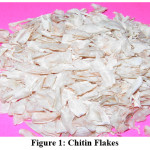 |
Figure 1: Chitin Flakes Click here to View figure |
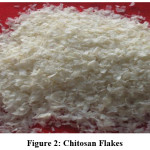 |
Figure 2: Chitosan Flakes Click here to View figure |
The depigmentation is a process for the removal of pigments from the shells. 1% hydrogen peroxide was added to the shells and kept overnight. 1% of sodium hypochlorite (NaClO) were added and autoclaved for 25 minutes to remove pigments from the shells. Then photo-bio lacing was carried out by keeping the sample in sunlight, until crampy appearance was obtained.9
Processed Chitin was washed with 500ml of 6N HCl and 2000 ml potassium hydroxide solution was added to it. The mix was boiled for 2h and cooled, then rinsed with distilled water, until it reaches neutral pH. Then it was filtered under vacuum, Chitin and Chitosan are shown in Figure 1 and 2 and was coinciding with the results of previous studies on Chitosan.10
Invitro – Antimicrobial Effect of plant Extracts
Oregano, Thyme and Mint leaves were collected and their moisture content was reduced to 8% approximately.11-12 To prepare crude extract, each 20g of Oregano, Thyme and Mint powders were together macerated with 80% methanol. The extract was allowed to stand for 3 days and concentrated by rotary evaporator after filtration. Then the concentrated extract was tested for its microbial activity. A disc of 6mm was impregnated with 3 drops of concentrated Solution and dried for 24h. Culture streaked plates were taken and the discs were gently pressed and incubation is carried out for 24hors by maintaining the temperature at 37°C. The zone of inhibition was observed and the diameter was measured. Inoculation of total flora and molds as working culture in Tryptic soy Agar (TSA) and acidified Potato Dextrose Agar (PDA) earlier poured plates. Except control plates all the other plates were slotted with a paper disk in the middle of plates. 5 μl volumes of antifungal agent (0.02%, w/v) were added to the paper disk. The paper disk was taken for incubation by 37 °C for 24 and 25 °C for 48 h for TSA and acidified PDA plates respectively.13 At final stage the bacteria or molds completely covering the plates and thus followed by measuring the zone of inhibition.
Coating solution Preparation
The materials used for the preparation of the edible chitosan coating solution are prawn shell, acetic acid as dissolving agent, glycerol as plasticizer and Tween 80 as surfactant.6, 14 Tween 80 is used to maintain hydrophilic – lipophilic balance to obtain a clear solution.15 The 2g Chitosan powder was autoclaved at 120°C to ensure sterility, 3% of acetic acid was added while the stirring operation takes place at room temperature and stirring is continued as vigorous for 2h. 0.2% of Oregano oil, 0.7% of Glycerol and 0.4% Tween 80 was added and stirred for 20 mins in a water bath at 45°C. The Chitosan coating of shallots was based on the dipping method of coating. In order to give convenient product, the peeled shallots were taken to study the effect of edible coating with uncoated shallot.
Analysis of physical and chemical parameters
Color of fresh and coated Shallot was determined using HUNTER COLOR LAB which records reflected light’s spectrum and then color coordinates (L, a and b values) were recorded. A regular white tile (L* = 93.96, a* = – 1.91, b* = 3.48) were used to standardize the instrument. The percentage of weight loss was analyzed by determining the weight of sample in alternative days for two weeks. Finally, the percentage of weight loss was then calculated from the results obtained from repeated analysis.
The Physio-chemical analysis was carried out chitosan powder by following standard methods. Moisture content and ash content were determined.16 Total phenol content,17 tannin content,18 titrable acidity,19 crude protein,20 calcium content, total carbohydrate content2 and Microbial studies for both yeast and bacteria21 were determined at frequent intervals from initial to final storage period (i.e. Initial day and after 2 weeks) in ambient condition at 32°C ±5°C for both Chitosan coated and uncoated shallots. The data were obtained for triplicate samples and the results were statistically analyzed and are interpreted as Figure (1 and 2) and tables (1, 2 and 3).
Microbial Studies
For the microbial studies 25 g of fresh onion free from any kind of infection and without naked decay portion was taken in a beaker with 225 ml sterile peptone water and kept in a mechanical shaker for 2h. The above prepared solution was diluted (serial dilution is considered) and then plated with potato dextrose agar and incubated for 72 h with the temperature at 25°C. The analysis was conducted and the results were statistically analyzed for average of 3 values and are interpreted as Fig (1 and 2) and tables (1, 2 and 3).
Results
Effects of essential oil in target organism by antimicrobial assay
The zone of inhibition with respect to the target bacteria was analyzed by measuring the diameter of the zone of inhibition from Figure 3. All three samples such as Oregano, Thyme and Mint were impregnated in the antimicrobial discs and the zones of inhibition were calculated by measuring the diameter of the zone formed on Figure 3, which were found to be 3.1cm, 1.5cm and 2.9cm for Oregano, Thyme and Mint leaves.
Oregano has been long-established its resilient antibacterial activity towards the target organisms. The zone of inhibition was found to be higher in Oregano as 3.1cm when compared with thyme and mint which is of lesser value of about 2.9 and 1.5. The analysis of the Mentha pulegium L. The extract was previously conducted and the interpretation showed a weighty activity against microorganisms and it also revealed that Gram-negative bacteria were the least susceptible microorganisms especially Escherichia coli 22. Spices like Oregano, Thyme and Mint possess antimicrobial activity which was also observed by other research studies.23
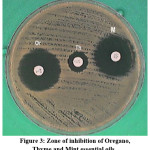 |
Figure 3: Zone of inhibition of Oregano, Thyme and Mint essential oils Click here to View figure |
Physio – chemical characteristics of Chitosan
The physio- chemical characteristics of Chitosan were tabulated in table 1. The moisture content, ash content, sieve size, color and deacetylation degree were found to be 7%, 1.0%, 150mm and 87. The chemical composition and physical parameters were in close conformity with the observations of research and also similar with commercially available Chitosan. The results obtained were compared with commercially available Chitosan and it is found to have similar values. The color also appeared to be same and the deacetylation degree analyzed by standard method 24 is about 87, when compared with commercial Chitosan the variation does not affect the coating solution. Hence it has been proved that the properties of Chitosan are similar to food grade Chitosan as per report25
Table 1: Physio – chemical Characteristics of Chitosan
| Parameters | Results |
| Grade | Food |
| Moisture content (%) | 7 |
| Ash content (%) | 1.0 |
| Sieve size (mm) | 150 |
| Color | Off white |
| Deacetylation degree | 87 |
Chitosan coating and its effect on weight loss during storage studies
The percentage weight loss in the coated Shallot sample was found to be about 5.31%, which is less when compared with uncoated Shallot samples, which shows the percentage weight loss as 7.52% after 2 weeks of storage period. The declining trend was observed for both coated and uncoated Shallots as displayed in figure 1. This variation in weight loss in shallots was observed due loss of moisture and decrease in nutrient content which are being utilized for root and shoot growth at the end of second week as shown in figure 3.
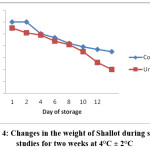 |
Figure 4: Changes in the weight of Shallot during storage studies for two weeks at 4°C ± 2°C Click here to View figure |
Effect of coating on color of Shallot during storage studies
Color is considered as the primary indicator of food product quality and freshness.26
Table 2: Color analysis report for Shallot
| SAMPLE | L* | a* | b* |
| Standard tile | 93.96± 0.006 | -1.91±0.001 | 3.48±0.001 |
| Fresh onion | 54.34±0.004 | 17.26±0.002 | 5.46±0.002 |
| Coated sample after one week | 59.20±0.004 | 13.15±0.001 | 6.29±0.002 |
| Coated sample after two weeks | 61.30±0.005 | 11.54±0.002 | 6.92±0.002 |
| Uncoated sample after one week | 62.23±0.002 | 10.45±0.001 | 7.78±0.001 |
| Uncoated sample after two weeks | 71.52±0.003 | 8.67±0.001 | 7.24±0.002 |
Note: Mean of three trials ± Standard error. Statistically significant at (P<0.0005)
L* – Bright when positive and dark when negative, a* – when positive it is Red and when negative, it is green, b * -when positive it is yellow and when negative it is green.
The color measurement results of Shallot samples are summarized in table 2. The L values showed an increase with an increase in the storage period as the color of onion reduces due to the utilization of pigment and flavonoids during the germination process. The a* value decreases with the increase in storage period as the color slowly depletes from red towards green. This may also be due to increase in the bacterial load. The b* value increases with the increase in storage period as it gets a lighter color, complexion when the storage period is increased. Aromatic acylation and Malonylation enhances pigment solubility in water and stabilizing anthocyanin structures which contributes to keeping the colour hue.27
Effect of Chitosan coating on Physio chemical characteristics of Shallot during storage period
The effect of Chitosan coating on Physio chemical characteristics of shallot during the storage period was analyzed. Physio chemical characteristics like crude protein, Calcium content, total carbohydrate, titratable acidity and total phenol content were observed at the end of 2 weeks of storage period. It was evident from the Table 3 that a significant difference occurred between the characteristics studied between coated and uncoated Shallots, which were also compared with fresh onion. Storage condition also influences the protein content as there is a chance of degradation during storage period by atmospheric conditions.28
Table 3: Changes in Physio chemical parameters of fresh, coated and uncoated peeled Shallot for two weeks at 4°C±2°C
| Type | Crude Protein content (%) | Calcium content (%) | Total Carbohydrate (%) | Total Phenol content (%) | Titratable acidity (%) |
| Fresh | 4.97 ± 0.033 | 4.00 ± 0.000 | 4.23 ± 0.033 | 32.23 ± 0.067 | 0.117 ± 0.0033 |
| Coated (after 2 weeks) | 3.97 ± 0.033 | 3.37 ± 0.033 | 3.77 ± 0.033 | 30.03 ± 0.033 | 0.067 ± 0.0033 |
| Uncoated (after 2 weeks) | 3.43 ± 0.033 | 2.97 ± 0.033 | 2.97 ± 0.033 | 29.00 ± 0.058 | 0.037 ± 0.003 |
Note: Mean of three trials ± Standard error. Statistically significant at (P<0.0005)
Statistical analysis was carried out using Analyze it (Version 2.2). The nutritional changes in the Shallot were analyzed and there was no significant difference between fresh and coated Shallot sample and there was a significant difference between fresh and uncoated sample.
Changes in Flavor
Pungency of Shallot is due to the amount of pyruvic acid present in it. Pungency is also related to the moisture content, as the moisture content decreases pungency or the level of pyruvic acid also decrease as shown in figure 2. The volatility is retained in less/reduced temperature as it gets locked into the product.
The shallot is mainly known for its characteristic flavor, which adds a delicious taste to almost all culinary food preparations. Therefore, the main challenge to preserve Shallot is to maintain the flavor. The flavor of coated onion is well maintained when compared with the uncoated one. Flavonoids can be used as chemical markers for quality control purposes.26
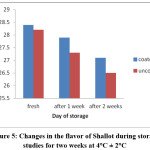 |
Figure 5: Changes in the flavor of Shallot during storage studies for two weeks at 4°C ± 2°C Click here to View figure |
Microbial Studies
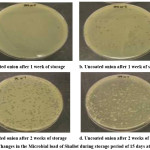 |
Figure 6: Changes in the Microbial load of Shallot during storage period of 15 days at 4°C ± 2°C Click here to View figure |
The microbial studies in figure 3 showed that number of microbes and decay is significantly less for coated onion samples compared with uncoated samples respectively. The inhibitory effect of Chitosan produced from prawn shells against fungi was studied by adding 0.2% oregano oil, 0.4% of Tween 80 (polysorbate 80) and 0.7% of Glycerol. The Zone of inhibition was obtained has which were found to be 3.1cm, 1.5cm and 2.9cm for Oregano, Thyme and Mint leaves. The addition of 0.1% Tween 80 to 1.5% Chitosan coating solution improved the compatibility of the solution on the Shallot skin. The number of microbial cells on freshly peeled garlic and onion falls as 10 – 1000 cells g-1 range as LAB (lactic acid bacteria) found in plants.29 Several reports show onions and its antimicrobial activity towards varied micro-organisms groups. Allicin, the common antimicrobial compound present in the onion is responsible for the antimicrobial activity and it is released from onion, when it is peeled and cut into pieces.30
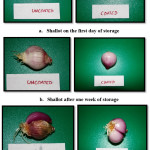 |
Figure 7: Appearance of Shallot during the storage period Click here to View figure |
The appearance of shallot was observed as in figure 4 and the change in the color and appearance characteristics was observed in the shallot during the storage period. Hence the coating study was relevant to previous studies conducted on storage of vegetables by coating and also using the packaging material having the Chitosan compound on packaging material31
Conclusion
The shallot is an important commercial and high economic valued vegetable grown in India as it is used daily for culinary purposes. The study was carried out to meet demand for peels Shallot in the market the study was conducted. The shallot peeling is tough and time-consuming process at the same time peeled Shallots are having shorter shelf life than unpeeled one. The edible coating material from prawn shell Chitosan with Oregano oil, Glycerol, Tween 80 was used to obtain uniform coating. Further the peeled Shallots was dipped in the coating solution and storage studies were conducted for 2 weeks. The results indicated that coated peeled samples have better retention of physiochemical compounds compared to fresh and uncoated samples. The colour, flavour and appearance of coated shallots were superior compare uncoated samples. In the study the results indicated that the microbial load of coated shallots was lesser than uncoated samples. Hence, prawn shell Chitosan was an effecting coating material for peeled Shallot shelf life extension.
Acknowledgement
The authors would like to extend their thanks to SRM Institute of Science and Technology, Deemed to be University (Formerly SRM University) for the support to carry out their work.
Funding
There is self – funding and no funding source.
Conflict of Interest
The author(s) declare no conflict of interest.
Reference
- Aisha, A.H., Fatma A. Rizk, A.M. Shaheen and Mona M. Abdel-Mouty. Onion Plant Growth, Bulbs Yield and its Physical and Chemical Properties as Affected by Organic and Natural Fertilization. Research Journal of Agriculture and Biological Sciences. 2007; 3(5): 380-388.
- Shilpa Talati and Porf. Prafulla Shah. Nutritional studies on fresh and dehydrated Onion (Allium cepa linn). 2009; ISSN-0974-2832, Vol. II, Issue-5.
- Asif, M., Ahmad, F., Tariq, M., Khan, A., Ansari, T., Khan, F., & Siddiqui, A. M. Potential of Chitosan alone and in combination with agricultural wastes against the root-knot nematode, Meloidogyne Incognita infesting eggplant. Journal of Plant Protection Research. (2017); 57(3):288-295.
CrossRef - Singh, D., & Sharma, R. R. Postharvest Diseases of Fruits and Vegetables and Their Management. Postharvest Disinfection of Fruits and Vegetables. (2018); 1-52.
CrossRef - Wang, H., Qian, J., & Ding, F. Emerging Chitosan-Based Films for Food Packaging Applications. Journal of Agricultural and Food Chemistry. 2018; 66(2):395-413. doi:10.1021/acs.jafc.7b04528
CrossRef - Chutichudet and Prasit Chutichudet. Effects of Chitosan Coating to Some Postharvest Characteristics of Hylocercus undatus (Haw) Brit. and Rose Fruit. Journal of Agriculture and Food Chemistry. 2004; 38: 1214 – 1217.
- Ghidelli, C., & Pérez-Gago, M. B. Recent advances in modified atmosphere packaging and edible coatings to maintain quality of fresh-cut fruits and vegetables. Critical Reviews in Food Science and Nutrition. 2017; 58(4):662-679.
CrossRef - Dequan Sun, Guobin Liang, Jianghui Xie, Xintao Lei and Yiwei Mo. Improved preservation effects of litchi fruit by combining Chitosan coating with ascorbic acid treatment during postharvest storage. African Journal of Biotechnology.2010; Vol. 9(22): pp. 3272-3279.
- Nessa, F., Masum, S. M., Asaduzzaman, M., Roy, S., Hossain, M., & Jahan, M. A Process for the Preparation of Chitin and Chitosan from Prawn Shell Waste. Bangladesh Journal of Scientific and Industrial Research. 2011; 45(4).
CrossRef - Hamed, I., Özogul, F., & Regenstein, J. M. Industrial applications of crustacean by-products (chitin, Chitosan, and Chito oligosaccharides): A review. Trends in Food Science & Technology. 2016; 48:40-50.
CrossRef - Skandamis, P., Tsigarida, E., & Nychas, G. J. E. Ecophysiological attributes of Salmonella typhimurium in liquid culture and within a gelatin gel with or without the addition of oregano essential oil. World Journal of Microbiology & Biotechnology. 2000; 16:31−35.
CrossRef - N. Kyu Kyu Win a, b, P. Jitareerat a, S. Kanlayanarat a, S. Sangchote. Effects of cinnamon extract, Chitosan coating, hot water treatment and their combinations of crown rot disease and quality of banana fruit. Journal of food, agriculture and environment. 2004; pg.340- 344.
- Ing, L. Y., Zin, N. M., Sarwar, A., & Katas, H. Antifungal Activity of Chitosan Nanoparticles and Correlation with Their Physical Properties. International Journal of Biomaterials, 2012; 1-9.
CrossRef - Han, J. H. Edible Films and Coatings. Innovations in Food Packaging. 2014; 213-255.
CrossRef - Kapetanakou, A., Manios, S., & Skandamis, P. Application of Edible Films and Coatings for Food. Novel Food Preservation and Microbial Assessment Techniques. 2014; 237-273.
CrossRef - AOAC, “Official Methods of Analysis,” (984.25). 17th Edn. Association of Official Analytical Chemistry, Maryland-14; 2000.
- Sadasivam S, Manickam A In: Biochemical methods for Agricultural Sciences.Wiley Eastern Ltd. New Delhi, India. 1992: 187-188.
- Burns RE Method of tannin analysis for forage crop evaluation. Tech. Bull. Georgia Agric. Station, Athens. 1963; 32: 62-66.
- Ranganna, S. Handbook of analysis and quality control for fruit and vegetable products. 2nd edition. Tata Mc Graw- Hill Publishing company Ltd. New Delhi. 1997.
- Lowry, O.H., Rosebrough, N.J., Farr, A.L., and Randall, R.J., Journal of Biological Chemistry., 193, p.265, 1951.
- Kanika Sharma. Manual of Microbiology Tools and Techniques, pp: 209. Amazon, Publishers, United States of America. Khopde SM, Indira PK, Mohan H. 2007.
- Mohammadi Amirabad, L., Jonoobi, M., Mousavi, N. S., Oksman, K., Kaboorani, A., & Yousefi, H. Improved antifungal activity and stability of Chitosan nanofibers using cellulose nanocrystal on banknote papers. Carbohydrate Polymers. 2018; 189, 229-237. doi:10.1016/j.carbpol.2018.02.041
CrossRef - Memnune sengul, Hilal yildiz, Neva gungor and Bulent cetin. Total phenolic content, antioxidant and antimicrobial activities of some medicinal plants. Pak. J. Pharm. Sci., 2009; vol.22, no.1, pp.102-106
- Guinesi L, Cavalheiro E. The use of DSC curves to determine the acetylation degree of chitin/Chitosan samples. Termochim Acta. 2006; 444: 128-33.
CrossRef - Inmaculada Aranaz, Marian Mengíbar, Ruth Harris, Inés Paños, Beatriz Miralles, Niuris Acosta, Gemma Galed and Ángeles HerasFunctional Characterization of Chitin and Chitosan. Current Chemical Biology. 2009; 3: 203-230.
CrossRef - Luiz Alberto Lira Soares, Valquíria Link BASSANI, George Pedro Ros2. Total Flavonoid Determination for the Quality Control of Aqueous Extracts from Phyllanthus niruri. American journal of. Pharmacy. 2003; 22 (3): 203-7.
- Rodrigues a, M.R. Pérez-Gregorio b, M.S. García-Falcón b, J. Simal-Gándara b, D.P.F. Almeida. Effect of meteorological conditions on antioxidant flavonoids in Portuguese cultivars of white and red onions. Journal of food chemistry. 2011.
CrossRef - Shi, S., Wang, W., Liu, L., Wu, S., Wei, Y., & Li, W. Effect of Chitosan/nano-silica coating on the physicochemical characteristics of longan fruit under ambient temperature. Journal of Food Engineering. 2013; 118(1), 125-131.
CrossRef - Daeschel, M. A., Andersson, R. E. and Fleming, H. P. Microbial ecology of fermenting plant materials. FEMS Microbiol. Rev. 46. 1987:357-367.
CrossRef - Eric Block, Xiao-Jia Cai,t Peter C. Uden, Xing Zhang, Bruce D. Quimby, G and James J. Sullivan. AIIium chemistry: Natural abundance of organoselenium compounds from garlic, onion and related plants and in human garlic breath. Pure & Appl. Chem. 1996; Vol. 68, No. 4, pp. 937-944.
CrossRef - Arvanitoyannis, I. S. The use of chitin and Chitosan for food packaging applications. Environmentally Compatible Food Packaging 2008; 137-158.
CrossRef

This work is licensed under a Creative Commons Attribution 4.0 International License.






